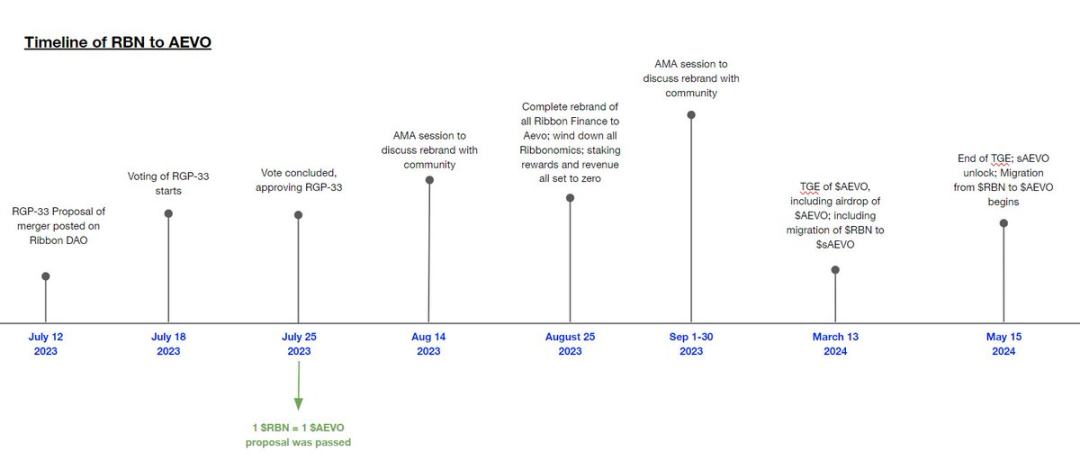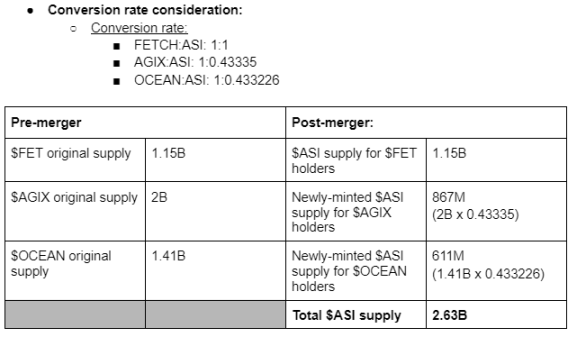Fallstudie zur Token-Migration: Was sind die wichtigsten Überlegungen für Projektgründer?
Originalautor: panadol girl
Originalübersetzung: Ruffy, Foresight News
Wenn Sie Gründer eines Kryptoprojekts sind und ein altes Token migrieren oder mit einem anderen Token zusammenführen möchten, um ihm ein „zweites Leben“ zu geben und die Ökonomie und den Nutzen des Tokens zu verändern, dann kann Ihnen dieser Artikel möglicherweise helfen.
Manche sagen vielleicht, dass Projekte nur eine Chance haben, ein Token herauszubringen, doch die Realität ist, dass sich Märkte und Narrative ändern, sich die Strategien und Visionen der Teams ändern und sich sogar die Erwartungen der Community ändern.
Daher müssen sich das Token-Branding und die Marktpositionierung weiterentwickeln, um relevant zu bleiben, und der Token-Nutzen wird sich damit ändern. Gründer und Teams sollten diese Wahl haben, solange sie vernünftig, gut durchdacht und von der Community genehmigt ist.
@karmen_lee und ich haben Stunden damit verbracht, uns intensiv mit fünf früheren Fallstudien zur Token-Migration und -Konsolidierung zu befassen, um ein umfassenderes Verständnis der wichtigsten Überlegungen, Migrationsmechanismen, Zeitpläne, Preisentwicklung und der Reaktion der Community zu erlangen.
Wir haben außerdem einen Entwurf auf hoher Ebene entwickelt, der Gründern und Entwicklern hoffentlich hilfreich sein wird. In diesem Artikel werden wir unsere Erkenntnisse aus diesen 5 Fallstudien sowie einige meiner eigenen Gedanken hervorheben:
-
MC -> BEAM
-
RBN -> AEVO
-
AGIX, FET, OCEAN -> ASI
-
KLAY, FNSA -> PDT
-
OGV -> OGN
1. MC->BEAM
Die Migration von Merit Circle zu Beam ist wahrscheinlich einer der erfolgreichsten und ausgereiftesten Fälle von Tokenmigration. Es ist ein großartiges Beispiel für den Übergang einer Anwendung (Chain Game Guild) zu einer Blockchain mit klaren und konsistenten Community-Kommunikations- und Vorschlagsprozessen.

Detaillierter Zeitplan für die Migration von Merit Circle zu Beam
Warum ein Upgrade?
-
Bessere Abstimmung zwischen Token-Branding und zugrunde liegendem Netzwerk.
-
Steigern Sie den Nutzen von Token.
-
Marktpositionierung und Markenbekanntheit.
-
Richten Sie die Aufmerksamkeit interner und externer Parteien schnell auf die neue Vision von BEAM.
Warum nicht einfach einen Token-Airdrop machen?
-
BEAM ist dazu konzipiert, MC-Token zu ersetzen und nicht mit ihnen zu koexistieren.
-
Da MC-Token ständig den Besitzer wechseln, ist es schwierig, einen fairen und genauen Airdrop durchzuführen.
-
Kostspielig (einschließlich Transaktionskosten).
Preisauswirkungen
-
Der BEAM-Preis stieg in den sechs Wochen nach der Migration um etwa 200%
-
Seit Beginn der Migration am 26. Oktober 2023 sind auch die MC-Preise um mehr als das Dreifache gestiegen.
2. RBN -> AEVO
Im DeFi-Bereich ist die Fusion von Ribbon Finance und Aevo ein interessanter Fall, der einen automatischen Staking-Mechanismus in den Fusionsprozess integriert.
Wechsel von 2 verschiedenen Produkten und 1 RBN-Token zu 1 einheitlichem Produkt und 1 neuem AEVO-Token.

Zeitleiste der Fusion von Ribbon Finance und Aevo
Warum fusionieren?
-
Bei der Lösung des Skalierbarkeitsproblems von DeFi-Optionen ist Ribbon auf Skalierbarkeitsschwierigkeiten gestoßen.
-
Synergie des Produktangebots.
-
Technische Vorteile von UI/UX: Aevo L2 Rollup zielt darauf ab, Benutzern Lösungen wie 0 Gasgebühren, reduzierte Auftragsverzögerungen, verbesserte Auftragsabwicklungsfunktionen und aktive Market Maker zu bieten.
-
Entwicklungsrichtung und -ziele: Eine leistungsstarke Handelsplattform für Derivate werden und mehr Produkte unter einer Marke anbieten.
Staking-Mechanismus
Für die umgewandelten AEVO-Token gilt eine Sperrfrist von 2 Monaten. AEVO-Token werden in sAEVO (Staked AEVO) umgewandelt und dann gesperrt, um die durch Ausverkäufe verursachte Preisvolatilität zu mildern.
3. AGIX, FET, OCEAN -> ASI
Einer der heißesten Fusionsfälle dieses Jahres war die Fusion von 3 KI-Token mit hohem FDV: Fetch.ai, SingularityNET und Ocean Protocol. Als die Nachricht im März erstmals bekannt wurde, telefonierte unser Team sofort mit Singularity, um die Gründe und Mechanismen zu verstehen.
Die wichtigste Erkenntnis, die wir aus diesem Fall gewinnen können, sind ihre Überlegungen zum Token-Umtauschverhältnis und die Gründe, warum sie auf die Token-Bewertung keinen Auf- oder Abschlag angewandt haben.
Warum fusionieren?
-
Konsolidierung der Liquidität: Liquidität ist teuer.
-
Bauen Sie das größte unabhängige Unternehmen im Bereich der Forschung und Entwicklung im Bereich künstliche Intelligenz auf.
Wechselkurs
-
Der Umrechnungskurs basiert auf dem Durchschnittskurs der letzten 15 Tage vor der Ankündigung.
-
Um Reibungsverluste bei Bewertungsverhandlungen zu vermeiden, müssen die Teams die Token nur unter denselben Marktbedingungen bewerten, ohne Auf-/Abschläge aufgrund von Liquiditäts-/Volumenunterschieden anzuwenden.
-
Als Basis-Token wurde FET gewählt, daher beträgt der Wechselkurs zu ASI 1:1.

Den derzeit laufenden zweistufigen Zusammenführungsprozess finden Sie Hier .
4. KLAY, FNSA->PDT
In diesem Jahr haben sich auch die beiden ältesten Token in Südkorea für eine Fusion entschieden. Einer wird von Kakao und der andere von LINE unterstützt. Dabei handelt es sich um die beiden größten Kommunikations-Apps in Südkorea. Ihre Vision ist es, die größte Blockchain in Asien mit einer Benutzerbasis von 250 Millionen Wallets, mehr als 240 DApps und Diensten zu werden.
Der Schwerpunkt unserer Forschung liegt auf den Verbrennungsmechanismen:
-
Ungefähr 22,9% des gesamten Vorrats an neuen PDT-Token werden vernichtet.
-
Der nicht in Umlauf gekommene Teil wird vernichtet (100%).
-
Zweck: Senkung der Inflation und Kontrolle des Angebots.
Sie veröffentlichten eine sehr detaillierte dokumentieren Erläuterung des Zerstörungsprozesses.
5. OGV->OGN
Zweck des Upgrades: Integration der gesamten Produktpalette von Origin mit einem einzigen Governance- und Umsatztoken, OGN, und Konsolidierung der Liquidität.
Die Erkenntnisse, die wir aus dieser Fallstudie gewannen, waren der Katalysator: Das Team erkannte, dass OGV falsch bewertet war und sein Marktkapitalisierungs-/TVL-Verhältnis viel niedriger war als bei anderen Wettbewerbern.
Abschluss
Eine Tokenmigration oder -fusion garantiert weder kurzfristige noch langfristige Preissteigerungen. Stellen Sie daher sicher, dass Sie einen guten und soliden Grund haben, warum Sie migrieren oder fusionieren.
Die Token-Migration ist kein einmaliges Ereignis. Kommunikation, Transparenz und Governance-Vorschläge sind ein fortlaufender Prozess. Deshalb glaube ich, dass einige Fälle erfolgreicher sind als andere.
Da der Migrationszeitraum für die meisten dieser fünf Fälle noch nicht beendet ist, müssen der Gesamtfortschritt des Produkts und des Ökosystems sowie die Token-Performance überwacht werden, bevor beurteilt werden kann, ob es sich um eine erfolgreiche Migration oder Fusion handelt.
Dieser Artikel stammt aus dem Internet: Fallstudie zur Token-Migration: Was sind die wichtigsten Überlegungen für Projektgründer?
Schlagzeilen: 200 Millionen XRP aus unbekanntem Treuhand-Wallet freigeschaltet, Wert über $119 Millionen. Laut Whale Alert-Überwachung wurden 200 Millionen XRP aus einem unbekannten Treuhand-Wallet freigeschaltet, Wert über $ 119.178.067 US-Dollar. Ethereum-Beacon-Chain-Einsätze übersteigen 34 Millionen ETH. Dune-Daten zeigen, dass der Gesamtbetrag der eingesetzten Ethereum-Beacon-Chain 34.048.349 ETH beträgt und die eingesetzten ETH 27,83% des Gesamtangebots ausmachen. Darunter erreichte der Einsatzanteil des Liquiditätseinsatzprotokolls Lido 28,82%. BTC fiel kurzfristig unter 63.000 USDT, mit einem 24-Stunden-Rückgang von 5,051 TP9 T. OKX-Marktdaten zeigen, dass BTC kurzfristig unter 63.000 USDT fiel und derzeit bei 63.128 USDT gehandelt wird, ein 24-Stunden-Rückgang von 5,051 TP9 T. Montenegrinisches Gericht bestätigt Urteil und ebnet damit den Weg für Do Kwons Auslieferung …







